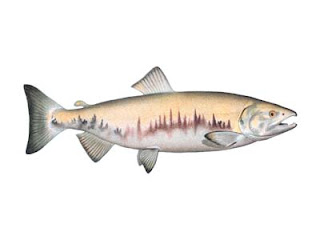One of the most common questions concerning freshwater fishing is "What species of freshwater fish can be caught during the winter?" Surprisingly, a wide range of freshwater species are active during the winter season and can be caught using a few basic techniques.
Depending on regional conditions, anglers may fish for trout, salmon, largemouth bass, smallmouth bass, crappie, sunfish, yellow perch, white perch, chain pickerel, northern pike, musky, catfish, or other species during the winter season.
In lakes, ponds, and rivers, fish usually move into in deep water during cold weather. During the winter, fish sometimes congregate in areas where currents are present, such as along channel edges or near creek entrances. On warm days, some species of fish will move into nearby shallow areas to feed on baitfish. During cold spells, fish return to the bottom or form schools at mid-depth.
A variety of factors influence fish behavior during the winter season; among them are sunlight, precipitation, air temperature, water temperature, turbulence, barometric pressure, and others. Changes in weather tend to occur more quickly in winter and these sudden changes may trigger fish to feed or shut down fish that were active only a few moments before.
On lakes, ponds, and creeks that remain ice free, anglers use a variety of techniques for catching fish during the winter. Deep jigging techniques are effective in many areas, especially when targeting panfish. Live baits are also effective in winter and anglers sometimes disagree on the issue of lures vs. bait. A few anglers fish multiple setups, utilizing both lures and live baits, or even combining the two.
Perhaps the most famous winter lure-bait combination is the jig-minnow combo. This traditional rig catches walleye, sauger, white bass, crappie, perch, pickerel, and other species. Jig styles vary regionally, with shad darts and marabou jigs being two of the most common. Some anglers prefer specific colors for minnow-jig combos, especially red/white, pink/white, and chartreuse/white.
In addition to jig-type hooks, anglers use a variety of hook styles when fishing live minnows or other baits. Rigs and hook preferences are frequently based on tradition or local fishing conditions. Factors such as water depth, visibility, current, drift speed, and targeted species all influence the type of hook, leader, bait, weights, and other tackle.
For artificial lure purists, many of the same factors impact tackle during winter fishing. In many cases, depth is by far the biggest factor in lure selection. Most lures suitable for winter fishing fall into 3 basic categories; lures that are heavy enough to sink, rigs that combine lures with weights, or lures that have built-in lips which cause them to dive when retrieved.
Among the most effective winter lures are traditional lead head jigs, metal jigs and spoons, Texas rigged soft plastics, and deep running crankbaits. Dropshot leaders are also popular, as they allow anglers to fish plastic worms and other weightless lures at the depths where fish are located.
During winter, a few coldwater stream fishermen continue to fish, catching rainbows, browns, brookies, and other members of the freshwater trout family. Although these fish may not move into deep structure like pond inhabitants, they do sometimes change their behavior.
Winter season fly fishermen usually pay credence to the age old adage and "match the hatch" on the stream to be fished. Winter patterns are dominated by nymph-type wet flies, small streamers, and other flies that resemble winter food sources.




















